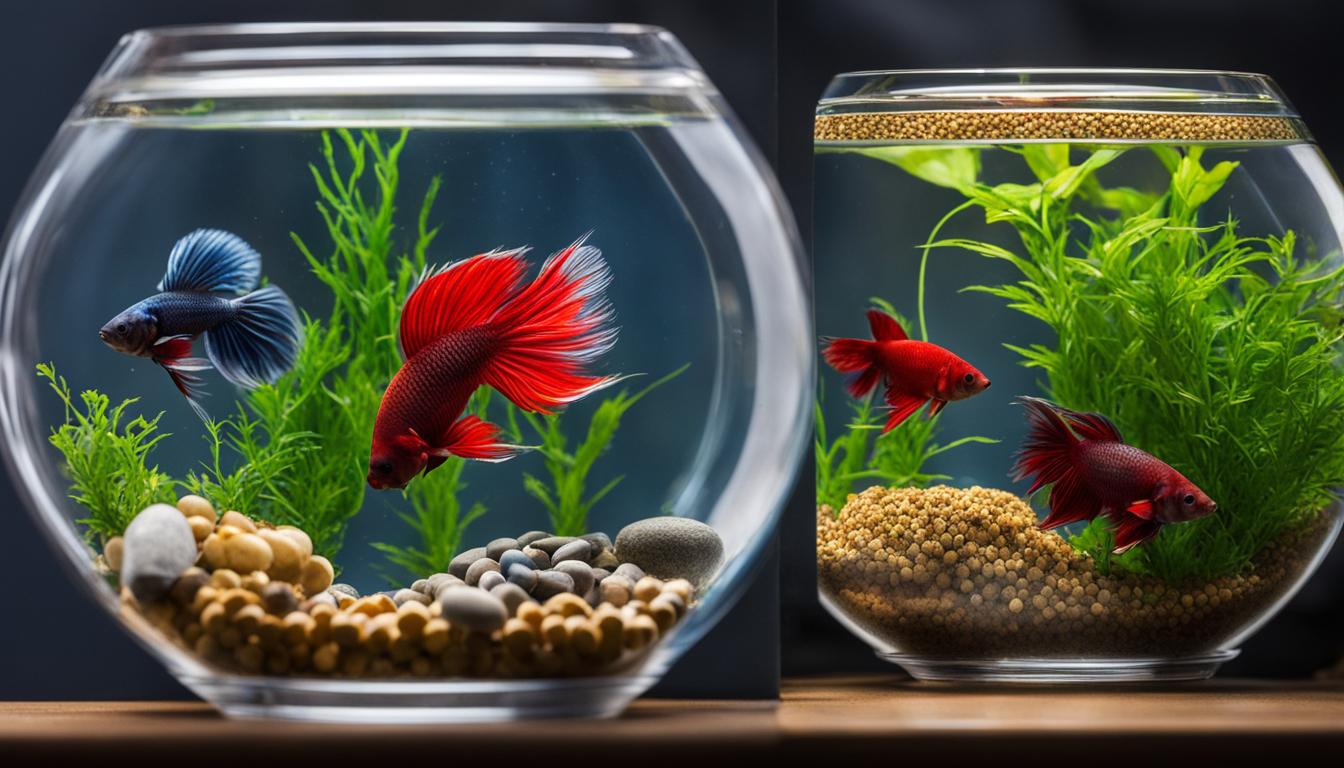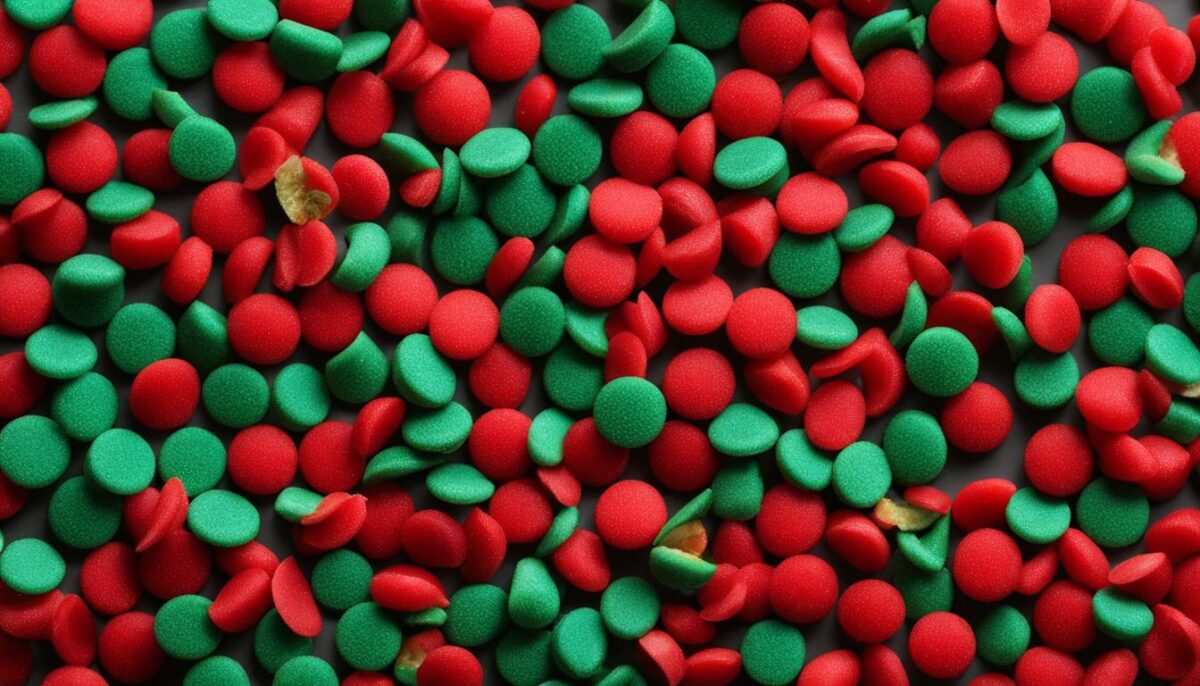Welcome to our guide on feeding betta fish! If you’re a proud betta fish owner, you may be wondering how often and how much to feed your finned friend for optimal health and happiness. In this article, we’ll provide you with the answers you need to ensure your betta fish receives a well-balanced diet.
Key Takeaways:
- A good daily portion for adult betta fish is about 1.8 grams, but it doesn’t have to be exact.
- Feed your betta one whole portion once a day, or two half portions twice a day to keep them happy and stimulated.
- Bettas love live food, but pellets are a good option for beginners.
- Choose a brand of fish food that contains the right nutrients, such as protein.
- Consider the size and age of your betta when determining the amount of food to feed them.
Now, let’s dive deeper into the world of betta fish feeding schedules and find out how to keep your betta healthy and satisfied!
Creating a Feeding Schedule for Your Betta Fish
When it comes to feeding your betta fish, establishing a proper feeding schedule is crucial to their health and well-being. By considering factors such as activity level, size, and tank temperature, you can ensure that your betta fish receives the right amount of food at the right times.
Betta fish are naturally active creatures, and their level of activity can affect their dietary needs. The more active your betta fish is, the more food they will require to stay happy and healthy. On the other hand, less active bettas may not need as much food.
The size of your betta fish also plays a role in determining their feeding schedule. Larger bettas generally require more food, while smaller bettas may need less. It’s important to observe your betta fish’s behavior and adjust their feeding amounts accordingly.
So, how often should you feed your betta fish? It is generally recommended to feed them once or twice a day, with at least a 12-hour gap between feedings. This allows your betta fish to digest their food properly and prevents overfeeding, which can lead to health problems and water contamination in their tank.
Additionally, fasting your betta fish for 24 hours every two weeks can be beneficial for their overall health. This period of fasting helps prevent obesity and allows their digestive system to cleanse and reset.
While establishing a feeding schedule, it’s essential to monitor the temperature of your betta fish’s tank. Bettas are tropical fish and thrive in water temperatures between 76-82°F (24-28°C). Feeding your betta fish when the water temperature is ideal ensures proper digestion and nutrient absorption.
Remember, overfeeding your betta fish can be harmful. It’s better to slightly underfeed than to overfeed. Uneaten food can cause water quality issues and put your betta’s health at risk. By carefully monitoring their feeding schedule and adjusting it as needed, you can help your betta fish lead a long and healthy life.
| Feeding Schedule | Recommended Amount |
|---|---|
| Once a day | 1.8 grams of food |
| Twice a day | 0.9 grams of food each time |
| Every two weeks (fasting) | No food for 24 hours |
Different Types of Betta Fish Food
When it comes to feeding your betta fish, there are various options available to ensure they receive a balanced diet. Understanding the different types of betta fish food can help you choose the best options for your finned friends. Here are some popular choices:
Pellets
Pellets are a favorite among bettas due to their high nutritional content and ability to keep the water clean. These compact, dense bites come in different sizes and flavors, catering to the preferences of different betta fish. Pellets are an excellent choice for beginners and can serve as the main staple in a betta fish diet.
Flakes
Flakes are another type of betta fish food, but they are less nutritionally dense compared to pellets. The main drawback of flakes is that they tend to sink, making it difficult for bettas to eat them. However, some bettas may still enjoy flakes, so it’s worth testing their preference. If you choose to feed your betta flakes, make sure to remove any uneaten food to prevent water contamination.
Live Food
If you want to provide your bettas with a natural and stimulating feeding experience, live food can be an excellent option. Betta fish love live prey, such as mosquito larvae, bloodworms, and daphnia. However, it’s essential to be cautious when feeding live food, as it can carry diseases or parasites. Always ensure the live food is of high quality and sourced from reputable sources.
Freeze-Dried Food
Freeze-dried food offers a convenient alternative to live food. It undergoes a freeze-drying process that removes moisture while preserving nutrients. While freeze-dried food lacks some of the benefits of live food, it can still be a valuable addition to a betta fish diet. However, it’s important not to overfeed freeze-dried food, as it can cause bloating if fed in large amounts.
Frozen Food
Frozen food, such as mysis shrimp and brine shrimp, is highly nutritious and closely mimics the natural diet of betta fish. These foods provide essential proteins and nutrients that contribute to the overall health and vitality of your bettas. Frozen food can be a regular part of their diet, and it’s recommended to read the labels and select options with high protein content and the right ingredients for bettas.
By offering a variety of betta fish food options, you can ensure that your fish receive a balanced and nutritious diet. Remember to consider your betta’s preferences, nutritional needs, and the overall health benefits of each type of food. Providing a diverse menu will help keep your bettas happy and thriving.
Conclusion
Feeding betta fish the correct amount and type of food is crucial for their overall health and well-being. It’s recommended to feed them 1.8 grams of food per day, either in one portion or split into two smaller portions. Pellets are a popular choice for bettas, but live food and frozen food are also beneficial.
When determining the amount of food to feed your betta, it’s important to consider their size, age, and activity level. Younger bettas will require less food, while older and bigger bettas may need more. By monitoring the tank temperature and maintaining a consistent feeding schedule, you can ensure that your betta is getting the right amount of food.
To provide a varied diet, consider offering live food such as bloodworms, brine shrimp, or daphnia. These options are highly beneficial for bettas, but be cautious as live food can carry diseases. Freeze-dried food is a good alternative, but it should not be the main source of nutrition. Frozen food, such as mysis shrimp and brine shrimp, is also highly nutritious and can be fed regularly to bettas.
By following a proper feeding regimen and providing a varied diet, your betta fish can thrive and live a healthy life. Remember to choose a brand of fish food that contains the right nutrients and protein content for bettas. With proper care and nutrition, your betta fish will bring you joy and beauty for many years to come.
FAQ
How often should I feed my betta fish?
It’s recommended to feed a betta fish one whole portion once a day or two half portions twice a day to keep them happy and stimulated.
How much should I feed my betta fish?
A good daily portion of food for an adult betta fish is about 1.8 grams. The recommended amount of pellets to feed a betta is between 4 to 6 per day.
What should I feed my betta fish?
Bettas love live food, such as bloodworms, brine shrimp, and daphnia. Pellets are a good option for beginners, but bettas tend to prefer pellets over flaked food. Freeze-dried food is a good alternative to live food, and frozen food can also be offered to bettas.
How do I determine the amount of food to feed my betta fish?
The size and age of the betta should be taken into account when determining the amount of food to feed them. Younger bettas will need less food, while older and bigger bettas may require more.
Can betta fish eat live food?
Yes, live food such as bloodworms, brine shrimp, and daphnia can be offered to bettas. However, it’s important to be cautious when feeding live food, as it can carry diseases.
What are the different types of betta fish food?
There are several types of betta fish food available, including pellets, flakes, live food, freeze-dried food, and frozen food. Pellets and frozen food are popular choices due to their nutritional value, while flakes and freeze-dried food can also be used as alternatives.
How should I create a feeding schedule for my betta fish?
When creating a feeding schedule, it’s important to consider the betta fish’s activity level, size, and the temperature of their tank. The more active the betta fish, the more food they will need. It’s recommended to feed bettas once or twice a day, with at least a 12-hour gap between feedings.
How can I improve my betta fish’s overall health?
Fasting bettas for 24 hours every two weeks can help improve their overall health. It’s also important to feed them the correct amount of food and monitor the tank temperature to maintain optimal conditions.

